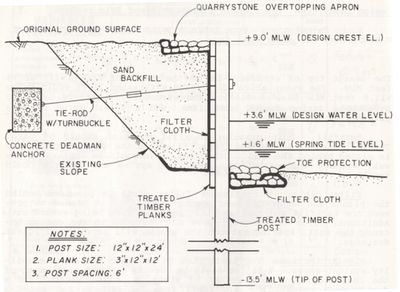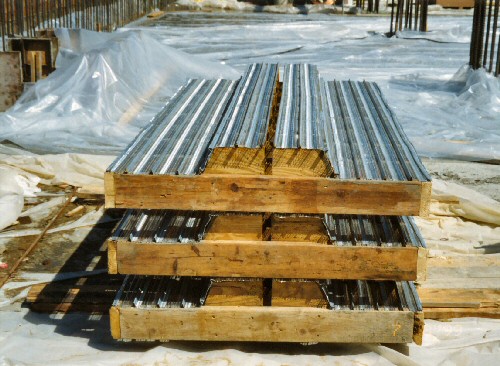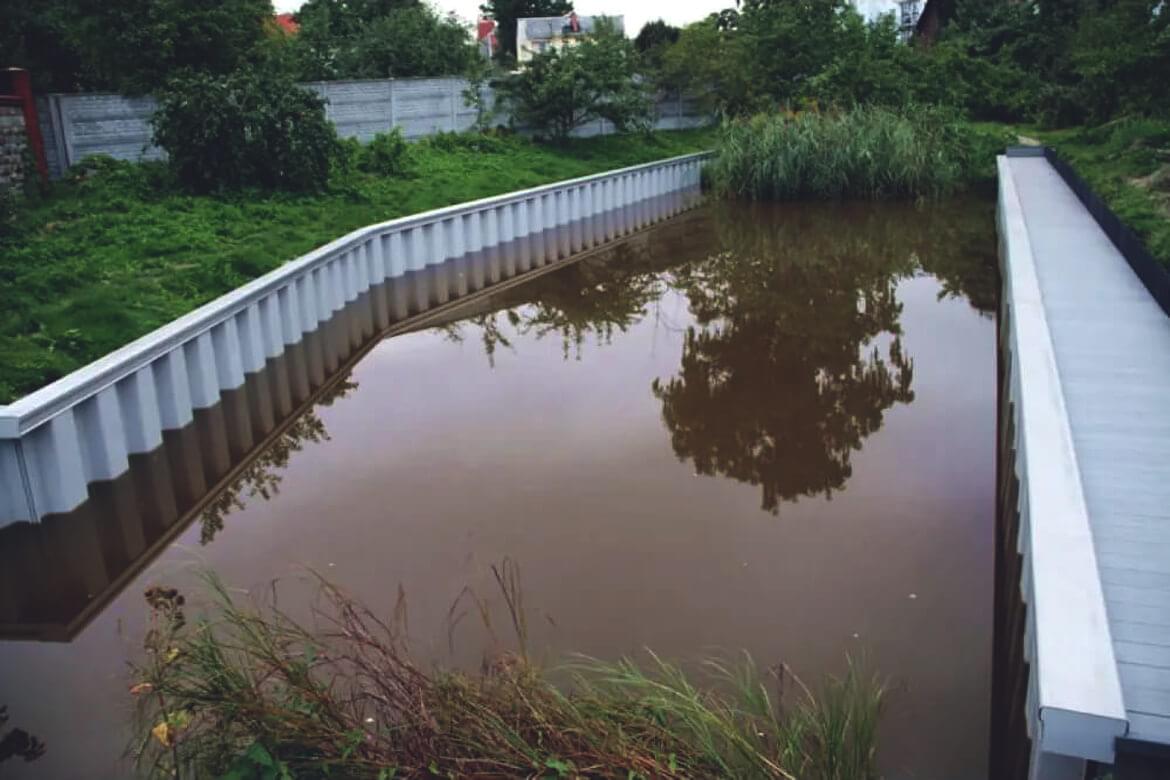Bulkhead on Lake Livingston: Key Components Used in Modern Architecture
Wiki Article
Checking Out the Different Uses of Bulkhead Frameworks in Modern Design
Bulkhead frameworks play a substantial duty in modern architecture, offering both practical and aesthetic purposes. They can define spaces, enhance storage services, and boost lighting. In commercial settings, they serve as focal factors that show brand name identification - Bulkhead on Lake Livingston. Furthermore, their combination commonly supports audio administration and sustainable techniques. Comprehending the full scope of their applications discloses much regarding contemporary style fads and individual experience. What ingenious uses bulkheads might arise in the future?Specifying Bulkhead Structures
Bulkhead structures play a critical role in modern design, functioning as necessary components in various structure layouts. These frameworks are typically specified as elevated ceilings or platforms, usually utilized to conceal mechanical systems, wiring, or pipes. Bulkheads can be found in both commercial and domestic setups, where they provide a smooth blend of functionality and looks. Their style can incorporate illumination components and various other ornamental aspects, boosting the total visual charm of an area.Normally created from products such as wood, metal, or drywall, bulkheads can be tailored to fit the architectural design and requirements of the structure (Bulkhead on Lake Livingston). They offer not only to hide undesirable facilities yet likewise to produce specified zones within open areas. By managing the flow of a room, bulkheads add to the spatial company, making them a significant aspect of contemporary architectural practice. Their meaning encapsulates both aesthetic and sensible measurements.
Practical Applications in Residential Design
Bulkhead frameworks play a necessary duty in household design by promoting room optimization techniques that optimize functional locations. They contribute visual design aspects that enhance the aesthetic allure of living spaces. In enhancement, these structures offer crucial architectural support solutions, guaranteeing the stability and safety and security of the home.Room Optimization Methods
As contemporary household styles increasingly focus on reliable use space, innovative techniques emerge to take full advantage of performance without giving up visual appeals. One popular technique entails the assimilation of bulkhead structures, which can define areas while giving vital storage space options. These frameworks can be used to create vertical storage space devices that enhance both organization and ease of access. Furthermore, multi-functional furnishings, such as foldable tables and exchangeable couches, matches bulkhead layouts, allowing areas to adjust to differing needs. Open up flooring strategies even more enhance spatial circulation, motivating flexibility in operation. Integrating built-in shelving and recessed lighting within bulkheads also adds to a structured atmosphere, making certain that every square inch of area is utilized properly and harmoniously within the overall style.Visual Style Components

Structural Support Solutions
In modern-day domestic style, a reliable architectural assistance solution is essential for maintaining the honesty of areas while maximizing layout and performance. Bulkhead frameworks play a substantial role in this scenario, working as both assistance and partitioning elements. They can hide mechanical systems, such as pipes and electrical wiring, while giving support to the ceiling and floor systems. By strategically placing bulkheads, engineers can develop defined areas within open floor strategies, boosting usability without compromising architectural security. In addition, these frameworks can accommodate lighting components, adding to both appearances and functionality. To summarize, bulkhead frameworks are essential in property design, offering flexible assistance services that improve both the functionality and visual charm of living areas.Enhancing Looks in Commercial Spaces
When industrial areas embrace innovative bulkhead frameworks, they not only define physical limits but also considerably improve the general looks of the setting. These building components serve as visual centerpieces, drawing focus and developing a sense of intrigue. By including varied products such as timber, glass, or metal, bulkheads can show a brand name's identity and objective, contributing to a natural layout.Moreover, the critical positioning of bulkheads can control light and shadow, including deepness and measurement to or else level areas. This interplay can transform a business area into an inviting ambience, encouraging consumer involvement. Additionally, using color and appearance in bulkhead design can evoke certain feelings, boosting the overall consumer experience. Ultimately, the thoughtful assimilation of bulkhead frameworks boosts the aesthetic appeal of commercial rooms, making them not only practical but also aesthetically charming, thereby promoting a lasting impression on site visitors.
Acoustic Efficiency and Audio Monitoring
Effective acoustic performance plays an essential duty in modern architecture, particularly within industrial spaces where sound management is vital. Bulkhead frameworks can substantially enhance acoustic top qualities by taking in audio, decreasing reverberation, and mitigating noise transfer in between locations. These features are particularly useful in atmospheres such as restaurants, offices, and cinemas, where clear communication and a pleasurable auditory experience are critical.The critical placement and design of bulkheads can aid create sound-buffer areas, effectively separating noisy areas from quieter ones. Materials used in bulkhead construction, such as acoustic panels and soft finishes, add to their sound-dampening capacities. Furthermore, the unification of bulkheads allows for the combination of sound-absorbing aspects without compromising visual appeal. By attending to acoustic performance, engineers can develop harmonious environments that enhance convenience, improve customer experience, and advertise efficiency, making bulkheads a vital component in the design of contemporary business areas.
Incorporating Bulkheads for Reliable Area Use
Usually overlooked, the assimilation of bulkheads in building layout can significantly improve space use in modern buildings. These structural components offer several sensible functions, using a way to conceal mechanical systems, electric wiring, and pipes without jeopardizing appearances. By strategically placing bulkheads, engineers can develop defined areas within open layout, thereby promoting far better company and circulation.Bulkheads can integrate storage options and lights attributes, making best use of the capability of otherwise thrown away vertical space. In domestic settings, they might delineate areas such as kitchen areas or living locations, while in industrial areas, they can boost the effectiveness of formats by clearly marking pathways and workspace.
Eventually, the thoughtful combination of bulkheads adds to a more aesthetically attractive and organized atmosphere, enabling adaptable spaces that can evolve with the demands of their owners. This approach not just maximizes space however also promotes a much more harmonious communication between type and feature.
Bulkheads in Public Design

Building Visual Enhancements
While many building aspects go for performance, bulkheads in public design offer a dual function by enhancing visual charm. These frameworks often create aesthetic rate of interest via their design, integrating effortlessly with surrounding aspects. By utilizing various materials, textures, and shades, bulkheads can add to a special identity for public areas, such as airport terminals, museums, and libraries. Their strategic placement aids to delineate areas, assisting visitors while including depth to the general style. Furthermore, bulkheads can accentuate lights, developing vibrant ambiences that change throughout the day. This aesthetic improvement not just boosts the site visitor experience but also cultivates a local color, making bulkheads a vital factor to consider in modern public design. Overall, bulkheads embody the fusion of kind and function.
Architectural Assistance Solutions
As architects look for ingenious ways to enhance the architectural integrity of public spaces, bulkheads emerge as vital elements in the design and building and construction process. These structures offer critical support, especially in areas based on heavy foot website traffic or vibrant lots. By dispersing weight uniformly, bulkheads help avoid architectural failing while allowing for functional style options. In huge places, such as stadiums and convention centers, bulkheads are frequently incorporated into the overall building structure, ensuring stability and safety. Additionally, they can facilitate the incorporation of energies and mechanical systems, adding to the performance of space usage. Eventually, bulkheads stand for a vital solution in modern-day public style, strengthening both performance and safety in community-focused settings.Environmental Defense Actions
Incorporating environmental security steps into public design has come to be increasingly vital as metropolitan developers prioritize sustainability along with architectural assistance. Bulkhead frameworks offer a double objective hereof, working as obstacles versus disintegration and flooding while at the same time enhancing the aesthetic allure of metropolitan landscapes. Their style frequently includes all-natural elements such as plants, which can boost air top quality and give environments for wild animals. Additionally, bulkheads can be engineered with absorptive materials that enable water absorption, lowering runoff and advertising groundwater recharge. This combination of ecological factors to consider not just protects the setting however likewise cultivates community durability versus climate modification. By utilizing bulkheads successfully, engineers add to sustainable city advancement that lines up with modern ecological goals.Future Trends in Bulkhead Style
Arising patterns in bulkhead layout mirror a growing emphasis on sustainability, innovation, and capability in modern architecture. Developers are progressively integrating green materials, such as recycled composites and bioplastics, to decrease environmental impact. Additionally, the assimilation of smart modern technology is becoming common, enabling bulkheads to serve multi-functional functions, including energy storage space and climate control.
In metropolitan settings, modular bulkhead systems are obtaining traction, using adaptability in style and convenience of installment. These systems can be adapted to different landscapes, enabling efficient area use. Furthermore, aesthetic factors to consider are advancing; bulkheads are now being made to improve aesthetic allure, frequently integrating creative elements that resonate with neighborhood society.
As environment resilience becomes a priority, future bulkhead layouts will likely prioritize flooding defense and stormwater administration, ensuring architectural integrity while dealing with ecological obstacles. This shift signifies an alternative strategy to architecture that satisfies both human needs and ecological obligations.
Often Asked Concerns
What Materials Are Generally Used for Bulkhead Building And Construction?
Common materials for bulkhead construction consist of concrete, steel, wood, and composite products. These choices offer resilience, structural stability, and resistance to ecological elements, making them suitable for different applications in building and construction and design jobs.Just How Do Bulkheads Impact Structure Power Performance?
Bulkheads boost constructing energy effectiveness by supplying thermal insulation and minimizing air leak (Bulkhead on Lake Livingston). They assist keep interior temperatures, thus reducing home heating and cooling down demands, inevitably causing reduced energy expenses and boosted environmental sustainabilityAre There Any Type Of Building Regulations Particular to Bulkhead Frameworks?
Yes, building codes certain Visit This Link to bulkhead frameworks exist, varying by location. These policies usually address safety and security, find out here now structural stability, and accessibility, making sure that bulkheads meet required requirements for building and construction and style within a given jurisdiction.Can Bulkheads Be Easily Customized or Eliminated Later On?
Bulkheads can typically be modified or removed, relying on their design and building. However, such changes may need mindful preparation and adherence to building codes to assure architectural stability and safety and security are maintained throughout the procedure.What Are the Expenses Connected With Mounting Bulkhead Frameworks?
The prices connected with setting up bulkhead structures can differ significantly, commonly influenced by materials, style intricacy, and labor. Normally, expenses range from moderate to high, depending upon the task's details needs and area.Bulkhead frameworks play a critical function in modern-day architecture, serving as vital elements in various structure layouts. Bulkhead structures play a vital function in domestic style by assisting in room optimization approaches that make best use of functional locations. Usually neglected, the combination of bulkheads in architectural design can considerably enhance room use in modern buildings. As architects seek cutting-edge ways to improve the architectural stability of public spaces, bulkheads arise as important parts in the style and building procedure. The prices connected with installing bulkhead frameworks can differ considerably, commonly influenced by products, layout intricacy, and labor.
Report this wiki page